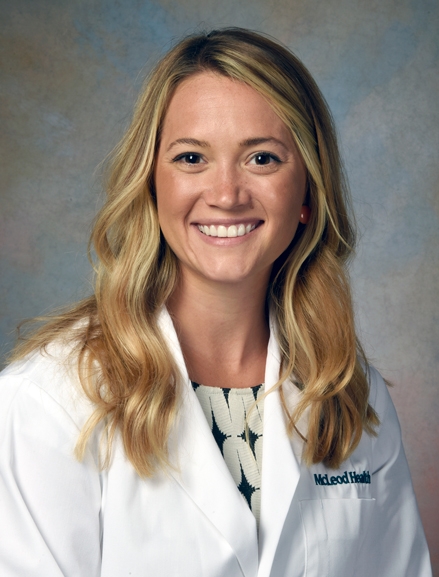Robotic-Assisted Hysterectomies

Jenna MacLennan, MD
McLeod OB/GYN Associates
Hysterectomy is a descriptive term that covers a range of surgical procedures and options. Different types of hysterectomies involve removal of more or fewer organs.
- Partial hysterectomy involves removing only the upper part of the uterus (not including the cervix). This is also called a subtotal or supracervical hysterectomy.
- Total hysterectomy includes removal of the uterus and cervix.
- Radical hysterectomy is normally recommended when cancer is suspected. Surgery removes the uterus, cervix, fallopian tubes, portions of the vagina and any lymph glands that might be affected. In some cases, surgery also removes the ovaries.
Hysterectomies and many other gynecological surgeries can often be performed using a minimally invasive approach known as robotic-assisted surgery. This option has drastically changed previously held notions about pelvic health surgery.
At its most basic, a robotic-assisted hysterectomy is the surgical removal of a woman’s uterus using a computer to control the surgical instruments.
Robotic hysterectomy uses three or four small incisions to remove the uterus through the vagina. The Gynecologist works at a separate console, viewing the internal organs through a 3D, magnifying monitor and operating with remote hand controls.
Benefits of robotic-assisted hysterectomies include:
- The robotic instruments are designed to reach the exact angle to stop a blood vessel’s bleeding.
- All the robot’s movements are very smooth and precise, minimizing damage to surrounding tissue and organs.
- Overall, there’s less blood loss and damage to surrounding tissue as well as a lower risk of infection compared to open procedures.
In addition, patients experience less pain after the surgery.
Normally, patients would stay in recovery for about four hours before being admitted overnight for observation. However, some patients can go home the same day of their surgery.
Focusing on early patient discharges, the McLeod Outpatient Surgery Department developed the Extended Recovery Program, which allows some patients to stay in recovery approximately six to eight hours before going home.
This has many benefits for GYN patients, especially those with chronic conditions and young families. The surgical process no longer disrupts medication management nor requires the additional stress of making family arrangements to accommodate a hospital stay.
Full recovery can take up to six weeks, but most women feel dramatically better and resume normal activities within two weeks.
Robotic hysterectomy is becoming more widely used for benign diseases of the uterus, including fibroids, abnormal bleeding, and adenomyosis, a condition in which the inner lining of the uterus (endometrium) grows into the uterine wall.
Robotic-assisted hysterectomy can also be used as part of larger procedures for the treatment and staging of endometrial cancer and early-stage ovarian cancer.
Keep in mind that Gynecologists always try to use other treatments until a woman no longer wants children. Younger women suffering from fibroids, abnormal bleeding, endometriosis, pelvic inflammatory disease or pelvic organ prolapse may also face a hysterectomy if other treatments are unsuccessful. Gynecological cancer represents a major health danger and will likely require hysterectomy.
Gynecologists often will remove the fallopian tubes to reduce, but not eliminate, the risks of ovarian cancer. Some cases of ovarian cancer actually come from the fallopian tubes.
If the cervix is removed, the risks of cervical cancer are almost eliminated. Total hysterectomy also eliminates the risks of uterine cancer. Removal of the ovaries and fallopian tubes during a hysterectomy dramatically reduces, but does not completely eliminate, the risks of ovarian cancer.
A hysterectomy is a major surgery that can have complications such as bleeding or infection. Most patients have significant and long-term improvements in their health post-hysterectomy and rarely regret having the procedure if medically indicated. This decision should be made in consultation with a Gynecologist to understand the surgical options, alternatives and benefits. Each woman’s choice depends on her medical history, other health conditions and reasons for the surgery.
Dr. Jenna MacLennan received her medical degree from the Medical University of South Carolina in Charleston. She also completed an Obstetrics and Gynecology residency at the Medical University of South Carolina. Dr. MacLennan cares for patients at McLeod OB/GYN Associates, located at 101 William H. Johnson Street, Suite 500, Florence, SC. To schedule an appointment, call (843) 777-7400.
-
McLEOD REGIONAL MEDICAL CENTER FLORENCE
843-777-2000 -
McLEOD DARLINGTON
843-777-1100 -
McLEOD DILLON
843-774-4111 -
McLEOD LORIS
843-716-7000 -
McLEOD SEACOAST
843-390-8100 -
McLEOD CHERAW
843-537-7881 -
McLEOD CLARENDON
803-433-3000



-
McLEOD REGIONAL MEDICAL CENTER FLORENCE
843-777-2000 -
McLEOD DARLINGTON
843-777-1100 -
McLEOD DILLON
843-774-4111 -
McLEOD LORIS
843-716-7000 -
McLEOD SEACOAST
843-390-8100 -
McLEOD CHERAW
843-537-7881 -
McLEOD CLARENDON
803-433-3000
 Find a Doctor
Find a Doctor  Locations
Locations  Services
Services